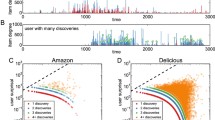Abstract
In social media such as Facebook, the most popular desire is to learn the news about other people. In this paper, we study the following problem related to information propagation: Suppose that there is a set U of N users in a social network. They meet online from time to time and share information they know about themselves and the other users in the network. Whenever a group g ⊂ U of users meet, they want to know who has the latest information about every user in U. A naive solution to this problem is to use timestamps. However, there are drawbacks to this scheme including the burden on the users to maintain reliable timestamps and the fact that the timestamps grow unbounded over time. It is natural to ask if it is possible to learn the latest information without using timestamps. We present an efficient method which removes the need to timestamp user information (news). Instead, only the meetings of the groups have to be indexed. Furthermore, we show that this indexing can be performed using a finite set of labels so that each user stores at most O(N 2 logN) bits of information. We also show that this bound can be improved in some cases if we have further information on the topology of the network.
Similar content being viewed by others
References
Cori, R., Metivier, Y.: Asynchronous mappings and asynchronous cellular automata. Inf. Comput. 106, 159–202 (1993)
Cori, R., Sopena, E.: Some combinatorial aspects of time-stamp systems. European J. Combin. 14, 95–102 (1993)
Dolev, D., Shavit, N.: Bounded concurrent time-stamps are constructible. In: Proc. of 21th Annual ACM Symposium on Theory of Computing, pp. 454–466 (1989)
Dwork, C., Waarts, O.: Simple and efficient bounded concurrent timestamping or bounded concurrent time-stamps are comprehensible. In: Proc. of 24th Annual ACM Symposium on Theory of Computing, pp. 655–666 (1992)
Fan, W., Geerts, F., Wijsen, J.: Determining the currency of data. In: Proc. of the 30th ACM Symposium on Principles of Database Systems, pp. 71–82 (2011)
Hedetniemi, S.M., Hedetniemi, S.T., Liestman, A.L.: A survey of gossiping and broadcasting in communication networks. Networks 18, 319–349 (1988)
Israeli, A., Li, M.: Bounded time-stamps. In: Proc. of 28th IEEE Conference on Foundations of Computer Science, pp. 371–382 (1987)
Lind, P.G., da Silva, L.R., Andrade, J.S., Jr, Herrmann, H.J.: Spreading gossip in social networks. Phys. Rev. E 76(3), 036117 (2007)
Mukund, M., Sohoni, M.: Keeping track of the latest gossip in a distributed system. Distrib. Comput. 10(3), 137–148 (1997)
Author information
Authors and Affiliations
Corresponding author
Rights and permissions
About this article
Cite this article
Rajagopalan, K., Srinivasan, V. & Thomo, A. A model for learning the news in social networks. Ann Math Artif Intell 73, 125–138 (2015). https://doi.org/10.1007/s10472-013-9349-7
Published:
Issue Date:
DOI: https://doi.org/10.1007/s10472-013-9349-7




